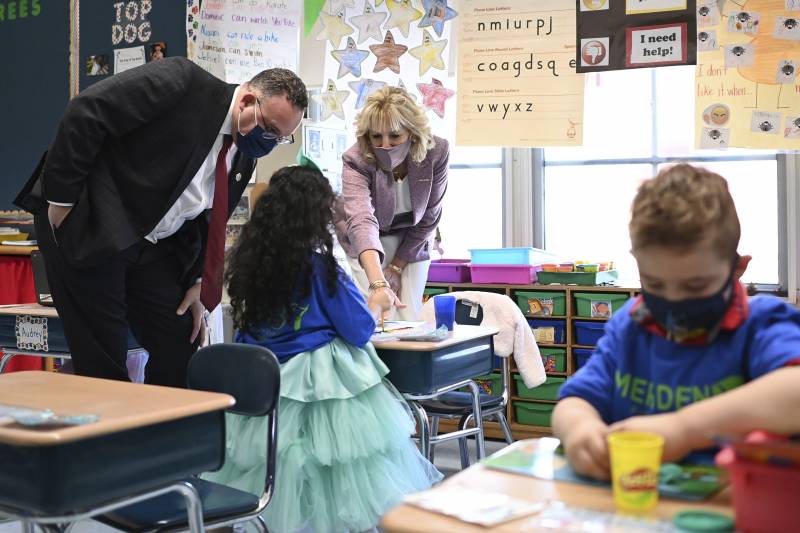I applaud that charge. First of all, it is our shared goal to reopen schools safely and quickly. You know, I haven't met an educator that doesn't agree that students learn best in school, and they really want our students to be learning in schools. So it's just a matter of implementing it in a manner that is expeditious and is aimed at really reopening schools quickly.
Q: Although the CDC says vaccinating teachers is not a requirement for opening schools safely.
You're right, Rachel. I can tell you from my experience in Connecticut, where over 90 percent of the students have an opportunity to learn in person today, and many students were learning in person before the vaccine was even approved. It can be done with a careful adherence to the mitigation strategies and close monitoring and where necessary, quarantining and closing — if the numbers escalate to the point where you can't safely assure students are in schools. However, we know that vaccination is a strategy that can just accelerate safe school reopening.
Q: Is part of this, just making teachers and staff comfortable with the idea of getting back in the classroom?
We know that there has to be a culture of trust, understanding, transparency. Those are all prerequisites to those technical strategies of convening the experts, sharing best practices, you know, the handbooks. It's really making sure that there's an understanding and a level of trust and comfort to reopen schools safely. And I think that's really why the American Rescue Plan is important, because it's going to ensure that we have those technical strategies, the ability to modify schools and provide the PPE that are needed. It gives us an opportunity to really address that digital divide once and for all and provide the long term needs. This is not just about turning on the lights, not just about unlocking the doors and letting students in. This is about recovering and making sure we're providing that important social-emotional development and support that our students need after experiencing a trauma like we just faced.
Q: So let's talk about the the physical upgrades that would need to happen. If we're talking about getting kids in school full-time in-person by the fall, I mean, the CDC recommends a physical distance of at least six feet between students. So it doesn't matter how many teachers should get back into schools. If schools don't have the physical space to meet that guideline, it's not going to happen. Is that guideline going to change?
You know, the first thing I heard you say is "fall." We really need to reopen schools quickly and safely as soon as possible. And distancing is critically important. As you know, that's one of the strategies that we've been working with, and we see in those districts that are successful bringing students back in. So following those mitigation strategies is critical in ensuring that, again, with the American Rescue Plan, we have the resources needed to expand and provide those environments that our students need to have safe in-person learning.
Q: So does that mean putting money into building bigger schools across this country? Or is the requirement for six feet of social distancing going to be amended?
I know that some of the funds can be earmarked for providing staffing if you are spreading students out or using different parts of the building differently. So, for example, yesterday in my visit with the first lady to Ben Franklin School in Meriden, Connecticut, I saw that the gymnasium was converted for part of the day into a classroom. So, that takes resources. And fortunately, with the warm weather coming soon, we can have classrooms set up outside and that's going to take resources as well. So I think it can be done, and it can be done safely.
Q: I talked to a high school teacher from the Bay Area in California yesterday who told me she is very worried about her students who have just disappeared. I mean, they don't engage their video. They don't turn in homework, or they just don't even log in to virtual classes at all. And we've heard this concern from a whole lot of teachers across the country over the past year. How are you, as the secretary of education, going to get those kids back?
You know, that teacher really speaks to the heart of the issue here. Every day that passes, students are being disengaged from that sense of community that schools provide, so that teacher is spot-on. And I think it's another example of where we know educators want their students back in schools, but safely. So part of our effort is to really collect data on the disengagement of students and ensure that our resources and our policy are aimed at closing those gaps that are being exacerbated. We know that some students are having better access to learning remotely than others, and we have to monitor that and make sure that we're providing resources to re-engage those students into that school community that, you know, as a parent myself, I know how important it is for our students to be reconnected into that school community. Not only for the academics, but for that sense of family that schools provide.
Q: America's public education system, I don't have to tell you, was already suffering before the pandemic from chronic underfunding. In your tenure, are you going to be able to address some of the problems that existed before? Or are you going to just try to get back to neutral, just get public education back to the baseline of what it was pre-COVID?



9(MDAxOTAwOTE4MDEyMTkxMDAzNjczZDljZA004))